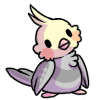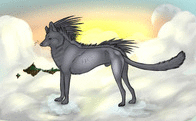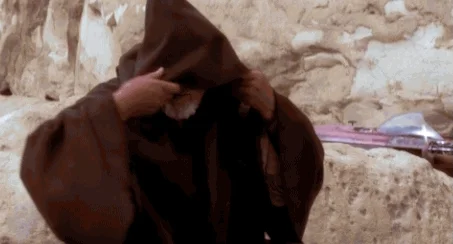Forum rules
Reminder: Copying another person's art without permission to reproduce their work is a form of art-theft!Click here to see the full Art Rules!
 by Metallic Dragon » Thu Jun 27, 2013 1:23 pm
by Metallic Dragon » Thu Jun 27, 2013 1:23 pm
What is a Lenarion?
Lenarions are large and dangerous beasts that resemble a kangaroo in build. They have long pointed ears with a small curl of fur at the tip. Their forepaws only have two long and seemingly delicate fingers with razor-sharp claws used for ripping and tearing. The beak that serves as their mouth is equipped with strong pincers that hold their prey tightly once caught, leaving almost no chance of escape. Lenarions are carnivorous and therefore only eat meat, preferring it raw. Their tail is thick and muscular, though it is used more for keeping them balanced while sitting. Lenarions never move about on all fours, hopping like their kangaroo counterparts instead.
-

Metallic Dragon
-
- Posts: 15639
- Joined: Sun Sep 28, 2008 9:14 am
- My pets
- My items
- My wishlist
- My gallery
- My scenes
- My dressups
- Trade with me
-
 by Metallic Dragon » Thu Jun 27, 2013 1:31 pm
by Metallic Dragon » Thu Jun 27, 2013 1:31 pm
General Rules:
1. No fighting/bickering, we respect everyone here.
2. Complaining about not winning is not allowed, there will always be more(well, if people are actually interested that is)
3. Do not mini-mod on the thread, I've got it handled until I hire some mods
4. Please don't ask to be added to staff, I'll hire staff as I see fit
5. Do not spam, it's unnecessary.
6. If you're caught stealing anything relating to Lenarions, you will be banned from the species permanently.
7. Lenarions are never to be bought, sold, or given away. Should you no longer want your lenarion for any reason, contact me and we'll work through re-homing it together.
8. Each person may own a total of 6 lenarions(this may change depending on demand)
9. We may offer customs but they will count toward your limit and you'll only be allowed 1
Artist Rules:
1. Lenarions come in a wide range of colors and hues, however, this does not mean make rainbows and super sparkle goober lenarions. Think of their background and design them accordingly. A neon pink lenarion with bright purple ears probably wouldn't be able to survive for very long in the wild.
2. I'm not going to completely confine you, but try to use no more than five colors on their fur. Their eyes can be any colors though
3. You may only have three competitions running at any one time. Please be aware that if you don't judge within a reasonable amount of time I will contact you about it. If you don't respond within a week or judge the competition, I will judge it myself. (This rule is to prevent contests from running for several months with no response from the artist)
4. Artists are allowed 2 customs and they do count toward your limit
5. Please ask me before doing lineart edits(other than items/accessories)
Custom Rules:
1. Customs must be accepted by me before they will be made
2. Forms are not first come first served
3. You may not request a custom based on a photo/character/piece of art/etc. These guys are a separate species and I will not be 'lenarion-izing' your old characters.
4. Dont' request a design that is too complex for you to re-draw
5. Each person is only allowed one custom and they do count toward your limit
How Do I Adopt?:
In order to adopt a lenarion, all you need to do is click on its picture and follow the instructions on its thread. The competitions themselves can be one of many different types so even if you're not good at drawing or writing, you can still adopt! Just find a competition that fits what you feel capable of and go for it! The adoptions themselves will always be free! No payment required other than your time/effort put into filling out the application!
You can also request a custom when they're open, but be aware that not every person who submits a form will be chosen.
-

Metallic Dragon
-
- Posts: 15639
- Joined: Sun Sep 28, 2008 9:14 am
- My pets
- My items
- My wishlist
- My gallery
- My scenes
- My dressups
- Trade with me
-
 by Metallic Dragon » Thu Jun 27, 2013 1:37 pm
by Metallic Dragon » Thu Jun 27, 2013 1:37 pm
General Disposition
Wild adult lenarions in general are extremely vicious, though they are known to shy away from most human contact. They will bite if provoked and wild adults should never be approached for any reason. When raised with human contact, it is possible to tame and handle a lenarion. They are still known to lash out on occasion even when hand-raised, however, and should only be cared for by experienced and mature handlers. Baby lenarions tend to sleep a lot and are known to be extremely curious toward humans. Not nearly as dangerous as adults, baby lenarions will approach a human if they fall asleep close to where a baby is hidden. These young lenarions can be captured and tamed if the proper equipment is used, though capturing the young in the wild can be extremely dangerous if their mother returns during capture.
Despite their ferocious disposition, lenarions can and do experience a wide range of emotions and those that are raised properly will generally form a strong bond with their human handlers.Size and weight
Adult female lenarions generally range anywhere between 3-5 feet long from beak to tail-tip and weigh between 110-170 lbs. Adult male lenarions are slightly larger and usually range between 6-8 feet long and weigh between 190-220 lbs.
A newly hatched joey is only about 6 inches long and only weighs about 1-2 pounds. A lenarion egg is usually around the same length and weight as the joey that hatches from it.Communication
Lenarions generally communicate with a mixture of sharp barking (similar to that of a cheetah) and clicking noises. Young lenarions occasionally make a higher pitched chirping sound when in distress, generally to alert their mother or father that they are in danger.Life Span
Lenarions are considered an adult at the age of four years. The prime breeding age is between five years and twenty years. Since female lenarions can only raise one clutch of eggs at a time, they need this wide age range in order to continue the species. If a female lays her first clutch at four years of age, she’ll be able to have as many as five healthy litters. After twenty years, many females become infertile or their eggs are laid with soft shells that bear weak and unhealthy joeys.
A male lenarion generally lives approximately twenty-five to thirty years old in the wild due to their tendency to squabble with each other over the females. Many males get seriously injured in these squabbles and die from infection or the inability to hunt.
Females in the wild can and usually do live longer than males, generally reaching the age of thirty to thirty-five. At this age they generally begin to slow down significantly and cannot hunt alone as effectively, putting them at risk for starvation and eventually death.
Captive lenarions as a whole usually live longer than wild lenarions, making it to the ripe old age of fourty to fourty-five. Feeding and Hunting habits
Lenarions are carnivorous and therefore only eat raw meat. Their diet generally consists of a mixture of small to medium sized herbivores and omnivores within their habitat. For this reason, the can be a nuisance to farmers nearby lenarion territories as they are known to prey on sheep, goats, young cattle, and even chickens. Luckily, most of the time lenarions are solo hunters and can be relocated or destroyed should they cause too much damage.
A lenarion hunt is generally fast-paced and violent. Since they cannot stalk their prey the way most predators would, they have to be agile and light on their feet when they hunt. Usually they track the herds from a distance, watching and waiting until they find an ideal moment to strike. Once they’ve picked out their prey, they take off at an astonishing speed, leaping forward at up to 75MPH and clearing distances of up to 30-40 feet per bound. Unlike cheetahs that cannot maintain their top speed for long, a lenarion generally maintains their speed for approximately two minutes, giving them ample time to approach and overtake their prey. Upon catching up, the lenarion will attempt to trip their prey, generally by moving close beside them and lashing at their legs with its thick tail. Once the prey stumbles, the lenarion goes in for the kill.Mating and Young Rearing

In general, males are willing to travel in pairs or groups of three. This allows them a higher rate of survival if they’re not the best hunters while also allowing them to move about their habitat freely in search of a lone female. Males are known to fight viciously once a mature female is discovered, the one that wins takes the female as his mate should she accept him.
Much like a platypus, lenarions lay eggs. Once the female has laid the eggs and incubation begins, the male stands by to watch over her. He still only hunts for himself, however, so the pair will take turns incubating the eggs in order to fulfill their own needs.
Incubation lasts approximately ninety days. At the end of this period, the joeys hatch using their pincers to pierce the shell and break free. At this time, they will immediately need to be cleaned and fed. This duty, of course, belongs solely to the new mother. For the first month of their lives, the joeys will need to be fed every half hour so their mother will be unable to leave the nest. The father will, at this point, spend the majority of his time hunting in order to feed his mate and himself.
At the age of two months old, the joeys can go a few hours between feeding so the parents will resume hunting for themselves while switching off watching over their joeys. By the age of four months old, the joeys will begin eating small chunks of regurgitated meat. The heavier food causes them to sleep for long periods of time while digesting, allowing both parents to leave the nest and tend to their own needs. When they are six months old, the joeys are finally large and energetic enough to leave the nest for the first time. Both parents stay close by to keep watch over their young as the joeys are known to take off and explore, often putting themselves in danger due to their intense curiosity of everything around them. This is a dangerous time for the joeys since they are still very young and vulnerable making them easy targets for predators.
For the next several months, they play with their siblings outside, strengthening their hind legs and instinctively practicing their hunting skills by chasing and tripping one another.
When they are a year old, the father will generally begin to grow slightly distant toward his offspring and their mother, beginning to disappear for longer periods of time as he begins to search for other adult males passing through the territory. When he finds one or two others, he will leave his offspring and mate behind so he can begin the process over again and pass on his genes elsewhere.
At this time, the female will begin taking her joeys with her to observe her as she hunts. It does not take long for them to begin stalking rabbits and other small prey, hopping furiously after the small animals with their small clawed fingers reaching and pincers clicking in excitement.
As the young lenarions continue to grow, they eventually begin picking their own prey out of the herds and attempt to take it down on their own. Many times for the first couple of years they will find themselves too small or weak to take down the larger prey. It’s not until they’re three years and six months old that they will have gained enough muscle mass and overall size to bring down prey large enough to fill their stomachs. After another six months of hunting with their mother, the males will generally leave on their own while the mother usually has to chase the females out of the territory herself. The mother will then go through a recuperation period of two months before she will be able to mate again.
-

Metallic Dragon
-
- Posts: 15639
- Joined: Sun Sep 28, 2008 9:14 am
- My pets
- My items
- My wishlist
- My gallery
- My scenes
- My dressups
- Trade with me
-
Who is online
Users browsing this forum: Speckles08 and 12 guests























